|
Mutis au naturel.
Science and art in the New Kingdom of Granada
26 November 2009 to 14 February 2010
Thesaurus exhibition room – La Nau
From
Tuesday to Saturday, from 10 to 13.30 and from 16 to 20 h.
Sunday, from 10 to 14 h. |
|
|
|
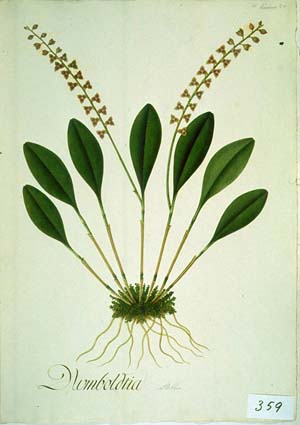
Anónimo
“Humboldtia”
Stelis superbiens
Lindl. (Orchidaceae)
Dibujo a la témpera sobre papel ; 54 x 38
cm.
Real Expedición Botánica del Nuevo Reino
de Granada (1783-1816).
Archivo del Real Jardín Botánico, CSIC. Div. III, lám.
359 |
|
|
|
Universitat de València
SECC, Sociedad Estatal de Conmemoraciones Culturales
Real Jardín Botánico de Madrid-CSIC
Curators:
Miguel Ángel Puig-Samper (CSIC)
José Antonio Amaya (Universidad Nacional de Colombia)
Mª Pilar de San Pío Aladrén (CSIC)
Mutis au Naturel.
Science and Art in the New Kingdom of Granada
“While in Spain there was still profound indifference
towards undertakings of this nature, all nations,
especially those who possessed establishments in
America, doggedly sought to gain knowledge of its
natural treasures and to set up both private and public
departments.”
(Mutis, 1763) |
|
|
|
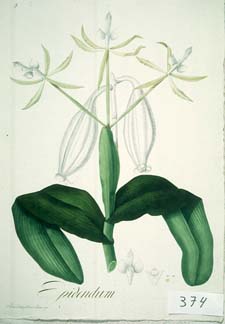
Nicolás
Cortés Alcocer
“Epidendrum”
Epidendrum longiflorum
Kunth
(Orchidaceae)
Dibujo a la témpera sobre papel ; 54 x 38
cm.
Real Expedición Botánica del Nuevo Reino
de Granada (1783-1816).
Archivo del Real Jardín Botánico, CSIC. Div. III, lám.
374 |
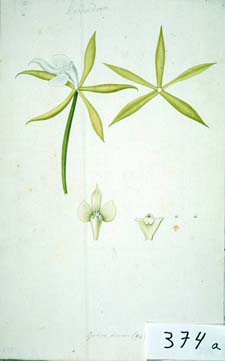
Anónimo
“Epidendrum” (Orchidaceae)
Dibujo a la témpera sobre papel ; 24,5 x
39 cm
Real Expedición Botánica del Nuevo Reino
de Granada (1783-1816).
Archivo del Real Jardín Botánico, CSIC. Div. III, lám.
374a |
|
|
|
The exhibition presents a chronological tour around the
life and scientific and cultural achievements of José
Celestino Mutis (1732-1808), an outstanding physician
and botanist from Cadiz known for his research into the
natural resources of the New Kingdom of Granada,
present-day Colombia. In Mutis’ own words, his botanical
expedition to the territory of New Granada was simply
intended to “honour the nation, yield public usefulness,
extend trade, and bring benefits to science, new funds
to the royal coffers and eternal glory to Your Majesty”.
Mutis
au naturel
includes the results of the latest research into his
life and works. In the 18th century, the
intellectual headed an independent scientific venture
which caused Santafé to become the core of Botanical
Enlightenment, with direct channels of communication to
European capitals like Uppsala, Paris, London or Madrid.
The exhibition also illustrates Mutis' great scientific
and artistic legacy as well as his commitment to
scientific and cultural progress in American
territories. |
|
|
|
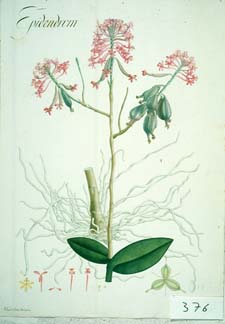
Vicente
Sánchez
“Epidendrum”
Epidendrum elongatum
Jacq. (Orchidaceae)
Dibujo a la témpera sobre papel ; 54 x 38
cm
Real Expedición Botánica del Nuevo Reino
de Granada (1783-1816).
Archivo del Real Jardín Botánico, CSIC. Div. III, lám.
376 |

Anónimo
Oncidium orgyale
Rchb.f. & Warsz.
(Orchidaceae)
Dibujo a la témpera sobre papel ; 54 x 38
cm
Real Expedición Botánica del Nuevo Reino
de Granada (1783-1816).
Archivo del Real Jardín Botánico, CSIC. Div. III, lám.
494 |
|
|
|
The first exhibition section -entitled Mutis and the
Enlightenment in Cadiz (1732-1757)- shows the
commercial, military and intellectual relevance of the
city at a time when the Marquis de la Ensenada intended
to rebuild Spain’s naval power with such outstanding
figures as Jorge Juan and institutions like the
Academia de Guardias Marinas, the Astronomic
Observatory and the Surgery Society, which all played a
role in Mutis’ education, under the tutorship of the
physician Pedro Virgili.
The exhibition continues with a section called Mutis
and
Madrid’s Enlightenment
(1757-1760), which describes Mutis' stay in the
Court of Madrid, where he mixed with scientific figures
such as Miguel Barnades, with whom he learned Carl von
Linné’s basics of botanical classification. Mutis was
also an interim lecturer of anatomy at the General
Hospital. |
|
|
|

Anónimo
Oncidium orgyale
Rchb.f. & Warsz.
(Orchidaceae)
Dibujo a la témpera sobre papel ; 25 x 39
cm
Real Expedición Botánica del Nuevo Reino
de Granada (1783-1816).
Archivo del Real Jardín Botánico, CSIC. Div. III, lám.
494a |
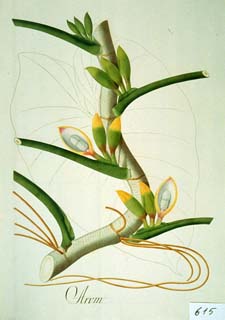
Anónimo
“Arum” (Araceae)
Dibujo a la témpera sobre papel ; 54 x 38
cm
Real Expedición Botánica del Nuevo Reino
de Granada (1783-1816).
Archivo del Real Jardín Botánico, CSIC. Div. III, lám.
615 |
|
|
|
The next section –By the route of the
Indies, in search for Madrid
(1760-1770)- describes Mutis’ situation at Court
before travelling to America, as well as the political
circumstances that formed the background to the journey,
in which he participated as the doctor of Viceroy Pedro
Messía de la Cerda. His idea was always to return to
Madrid’s court with scientific glory and so be able to
set up a new Department of Natural History with a
Botanical Garden.
The next section is devoted to the new role of Mutis as
Naturalist, priest businessman and miner (1770-1778).
It shows how Mutis gradually adapted his plans for
the metropolis to the New World, ultimately creating a
scientific tradition in the New Kingdom of Granada. It
explains his project for trading in tea from Bogota on
his own account, his attempt to exploit the silver mines
of El Sapo and the discovery of cinchona in Santafé
(1772). |
|
|
|
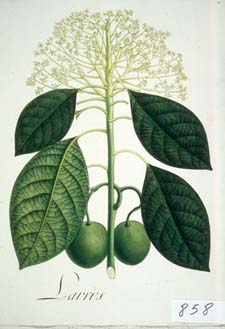
Anónimo
“Laurus” (Lauraceae)
Dibujo a la témpera sobre papel ; 54 x 38
cm
Real Expedición Botánica del Nuevo Reino
de Granada (1783-1816).
Archivo del Real Jardín Botánico, CSIC. Div. III, lám.
858 |

Anónimo
“Eupatorium”
Llerasia lindenii
Triana (Compositae)
Dibujo a la témpera sobre papel ; 54 x 38
cm
Real Expedición Botánica del Nuevo Reino
de Granada (1783-1816).
Archivo del Real Jardín Botánico, CSIC. Div. III, lám.
915 |
|
|
|
Sebastián José López Ruiz (1778-1783) and his commission
in Santafé de Bogotá
are at the centre of the following section, which
explains the commission given to this Panamanian
naturalist to exploit the cinchona bark and the cinnamon
of the New Kingdom, in competition with Mutis, attached
to the expedition of Hipólito Ruiz and José Pavón to
Peru and Chile.
In The Royal Botanical Expedition of the New Kingdom
of Granada of José Celestino Mutis (1783-1790) we
see the official preparations of the Expedition, for
which Mutis recruited a Creole team and the organisation
of an expedition painting studio during his stay in the
town of Mariquita, which painted coloured illustrations. |
|
|
|
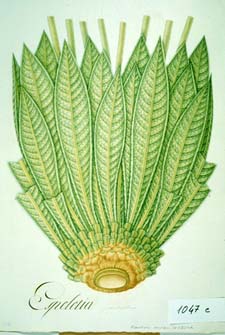
Anónimo
“Espeletia” (Compositae)
Dibujo a la témpera sobre papel ; 54 x 38
cm
Real Expedición Botánica del Nuevo Reino
de Granada (1783-1816).
Archivo del Real Jardín Botánico, CSIC. Div. III, lám.
1047c |
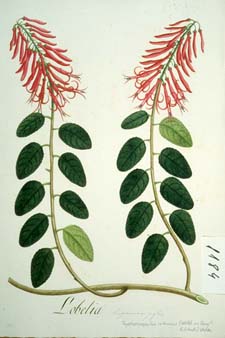
Anónimo
“Lobelia”
Siphocampylus retrorsus
(Willd. ex Schult.)
Vatke (Campanulaceae)
Dibujo a la témpera sobre papel ; 54 x 38
cm
Real Expedición Botánica del Nuevo Reino
de Granada (1783-1816).
Archivo del Real Jardín Botánico, CSIC. Div. III, lám.
1184 |
|
|
|
The continuation of his voyage appears in the section
Mutis’ period in Santafé and his final years
(1791-1808), offering a description of his new team,
which included Francisco Antonio Zea, Francisco José de
Caldas, etc., and of the closure of the state cinchona
company. It also comments on the meeting and scientific
exchanges of Alexander von Humboldt and Aimé Bonpland
with Mutis in Santafé de Bogotá.
The Legacy of Mutis
shows the rich and extensive botanical and iconographic
collection that the intellectual from Cadiz left after
his death in Santafé in 1808, which was transferred to
Madrid following General Morillo’s military
intervention.
The exhibition comes to an end with a presentation of
examples from the Artistic Treasures of the Botanical
Exhibition, with numerous drawings and illustrations by
Mutis. Finally, the last section –entitled Artists
for the Kingdom- shows how Mutis’ works and his
artistic innovation transformed the society of New
Granada. |
|
|
|
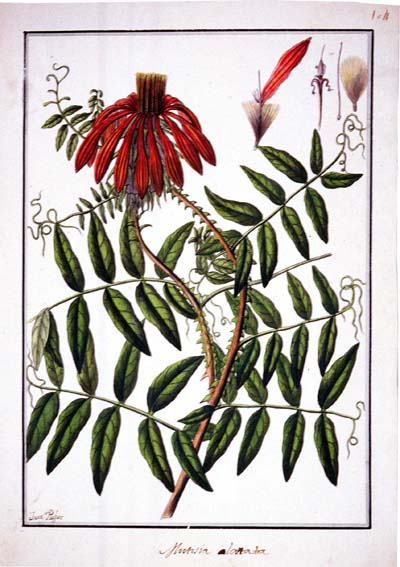
Francisco Pulgar
“Mutisia lanata” (Compositae)
Dibujo a tinta y acuarela ; 25,5 x 36,5
cm
Expedición Botánica al Virreinato del
Perú (1777-1788).
Archivo del Real Jardín Botánico, CSIC. Div. IV, lám.
1221 |
|
|